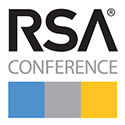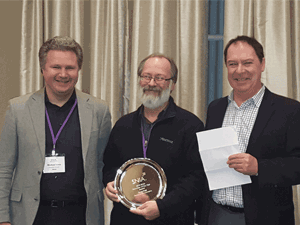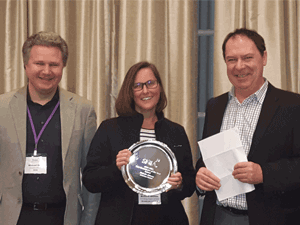 February 14-17 2017, join SNIA in San Francisco at the RSA Conference in the OASIS Interop: KMIP & PKCS11 booth S2115. OASIS and SNIA member companies will be demonstrating OASIS Key Management Interoperability Protocol (KMIP) through live interoperability across all participants. SNIA representatives will be on hand in the booth to answer questions about the Storage Security Industry Forum KMIP Conformance Test Program, which enables organizations with KMIP implementations to validate the protocol conformance of those products and meet market requirements for secure, plug-and-play storage solutions. And Eric Hibbard, Chair of the SNIA Security Technical Work Group and CTO Security and Privacy, HDS Corporation, will participate in the “Can I Get a Witness? Technical Witness Bootcamp” session on February 17.
February 14-17 2017, join SNIA in San Francisco at the RSA Conference in the OASIS Interop: KMIP & PKCS11 booth S2115. OASIS and SNIA member companies will be demonstrating OASIS Key Management Interoperability Protocol (KMIP) through live interoperability across all participants. SNIA representatives will be on hand in the booth to answer questions about the Storage Security Industry Forum KMIP Conformance Test Program, which enables organizations with KMIP implementations to validate the protocol conformance of those products and meet market requirements for secure, plug-and-play storage solutions. And Eric Hibbard, Chair of the SNIA Security Technical Work Group and CTO Security and Privacy, HDS Corporation, will participate in the “Can I Get a Witness? Technical Witness Bootcamp” session on February 17.
 The following week, February 21-23, join SNIA at Container World in Santa Clara CA. Enabling access to memory is an important concern to container designers, and Arthur Sainio, SNIA NVDIMM Special Interest Group Co-Chair from SMART Modular, will speak on Boosting Performance of Data Intensive Applications via Persistent Memory. Integrating containers into legacy solutions will be a focus of a panel where Mark Carlson, SNIA Technical Council Co-Chair from Toshiba, will speak on Container Adoption Paths into Legacy Infrastructure. SNIA experts will be joined by other leaders in the container ecosystem like Docker, Twitter, ADP, Google, and Expedia . The SNIA booth will feature cloud infrastructure and storage discussions and a demonstration of a multi-vendor persistent memory solution featuring NVDIMM! (P.S. – Are you new to containers? Get a head start on conference discussions by checking out a December 2016 SNIA blog on Containers, Docker, and Storage.)
The following week, February 21-23, join SNIA at Container World in Santa Clara CA. Enabling access to memory is an important concern to container designers, and Arthur Sainio, SNIA NVDIMM Special Interest Group Co-Chair from SMART Modular, will speak on Boosting Performance of Data Intensive Applications via Persistent Memory. Integrating containers into legacy solutions will be a focus of a panel where Mark Carlson, SNIA Technical Council Co-Chair from Toshiba, will speak on Container Adoption Paths into Legacy Infrastructure. SNIA experts will be joined by other leaders in the container ecosystem like Docker, Twitter, ADP, Google, and Expedia . The SNIA booth will feature cloud infrastructure and storage discussions and a demonstration of a multi-vendor persistent memory solution featuring NVDIMM! (P.S. – Are you new to containers? Get a head start on conference discussions by checking out a December 2016 SNIA blog on Containers, Docker, and Storage.)
 Closing out February, find SNIA at their booth at USENIX FAST from February 27-March 2 in Santa Clara, CA, where you can engage with SNIA Technical Council leaders on the latest activities in file and storage technologies.
We look forward to seeing you at one (or more) of these events!
Closing out February, find SNIA at their booth at USENIX FAST from February 27-March 2 in Santa Clara, CA, where you can engage with SNIA Technical Council leaders on the latest activities in file and storage technologies.
We look forward to seeing you at one (or more) of these events!









 Jim Pappas from Intel Corporation received the Exceptional Leadership Award for his outstanding leadership advancing the cause of persistent memory within SNIA leading to an impact both on the industry and the Association. The recent 5th annual
Jim Pappas from Intel Corporation received the Exceptional Leadership Award for his outstanding leadership advancing the cause of persistent memory within SNIA leading to an impact both on the industry and the Association. The recent 5th annual  Doug Voigt from Hewlett Packard Enterprise received the Volunteer of the Year Award for his consistent contributions during 2016 furthering the work of the
Doug Voigt from Hewlett Packard Enterprise received the Volunteer of the Year Award for his consistent contributions during 2016 furthering the work of the  le Ahlvers from Broadcom Limited received the New Contributor of the Year Award for her leadership of a new SNIA program within the
le Ahlvers from Broadcom Limited received the New Contributor of the Year Award for her leadership of a new SNIA program within the  The
The  The SFF Task Force received the Significant Impact by a Previously Existing Technical Work Group (TWG) or Task Force Award for its member work and efforts to establish the
The SFF Task Force received the Significant Impact by a Previously Existing Technical Work Group (TWG) or Task Force Award for its member work and efforts to establish the  The SNIA Scalable Storage Management Technical Work Group received the New SNIA Group of the Year Award for its innovative, groundbreaking
The SNIA Scalable Storage Management Technical Work Group received the New SNIA Group of the Year Award for its innovative, groundbreaking  SNIA is well known for its technology-focused, no vendor-hype conferences, and this one-day event will feature 12 presentations and two panels that will “level set” the discussion, review persistent memory usage, describe applications incorporating PM available today, discuss the infrastructure and implementation, and provide a vision of the “next generation” of persistent memory.
You’ll meet speakers from SNIA member companies Intel, Micron, Microsemi, VMware, Red Hat, Microsoft, AgigA Tech, Western Digital, and Spin Transfer. Live demonstrations of persistent memory solutions will be featured from Summit underwriters Intel and the SNIA Solid State Storage Initiative, and Summit sponsors Microsemi, VMware, AgigA Tech, SMART Modular, and Spin Transfer.
Registration is complimentary but limited -visit
SNIA is well known for its technology-focused, no vendor-hype conferences, and this one-day event will feature 12 presentations and two panels that will “level set” the discussion, review persistent memory usage, describe applications incorporating PM available today, discuss the infrastructure and implementation, and provide a vision of the “next generation” of persistent memory.
You’ll meet speakers from SNIA member companies Intel, Micron, Microsemi, VMware, Red Hat, Microsoft, AgigA Tech, Western Digital, and Spin Transfer. Live demonstrations of persistent memory solutions will be featured from Summit underwriters Intel and the SNIA Solid State Storage Initiative, and Summit sponsors Microsemi, VMware, AgigA Tech, SMART Modular, and Spin Transfer.
Registration is complimentary but limited -visit
Leave a Reply